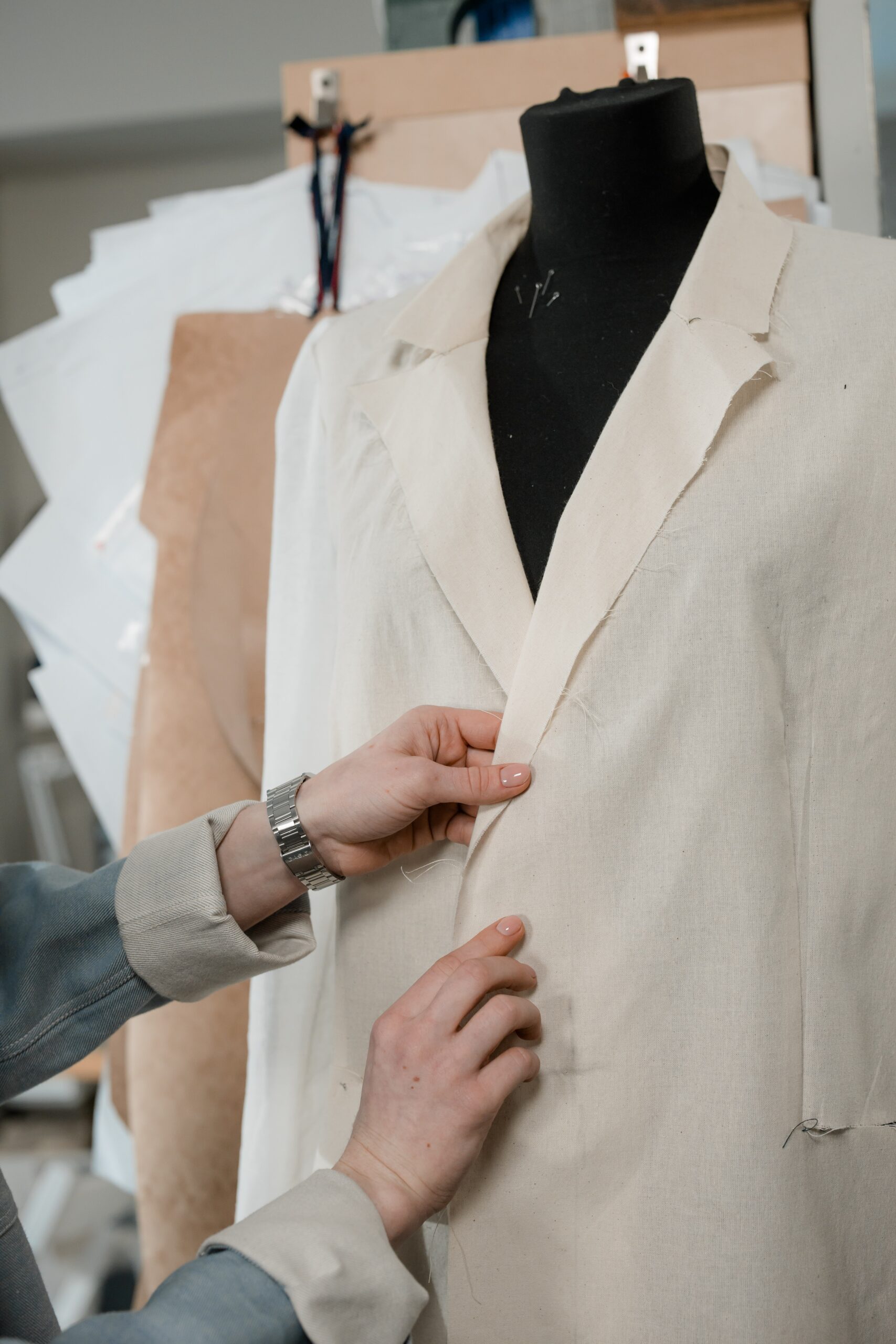Fashion and Art: An everlasting union
“One should either be a work of art or wear a work of art”– Oscar Wilde
The romance between fashion and art is not a secret affair, it’s a long and probably unending rendezvous. It goes back to the 16th century Renaissance, an era of exploration and rediscovery of individuality. Artists were greatly inspired from the fashion of the times, they mostly designed female costumes that were also representative of the socio-economic milieu of the era. Then periods of Neo-classicism, Romanticism, Aestheticism, Realism, Impressionism, and Surrealism followed, which gave a refreshing direction to the blend of art and fashion. An Aesthete American artist James Abbott McNeill Whistler during this period incorporated fashion in his art. The book Art and Fashion (2005) says about him :
‘Whistler was someone who assimilated the fashions of his time as an integral component of his art, such as the craze for everything Japanese that was sweeping Paris and London’…’ He appreciated beauty and styling women, and concentrated on them in his portraiture, painting images of beauty that could be appreciated on their aesthetic merit alone.’[1]
By the time the 20th century arrived, the blend of art and fashion had become an unbreakable bond. A couturier named Paul Poiret was couturier marked the beginning of a new era of fashion as well as the art world during the early years of the 20th century, giving birth to a style which is known today as “Art Deco”[2]. He was one of the firsts and most talented to fuse fashion successfully to the arts. Thus, it will not be an overstatement to call fashion an art form. However, we usually shy away from calling it a true form of art, and hence calling it so is accompanied by adjectives like “fine” or “applied”. But, art is art, and does it really matter what type of art? And, what constitutes art or what doesn’t is itself a matter of debate amongst artists and art scholars. Over the centuries, different philosophers[3] like Plato, Kant, and Hegel have attempted to define what art is but in a way, formulation of a technical definition of art would be placing constraints on something that can encompass any and everything. Art isn’t about books or museums, art can be present in our daily lives – it’s boundless. So, who says art cannot be wearable? Taking a little time travel to the early 20th century, let Coco Chanel and Salvador Dali answer this question for us – a French woman who emancipated women globally from “corseted silhouette” and a Spanish man who came to be known as one of the world’s best surreal artists. Surrealism touched the world of fashion in a way that had not been done before by any of the art movements.

Salvador Dali and Coco Chanel sharing a cigarette
Source: Daily Art Magazine
“Chanel’s originality was the opposite of mine… I have always shamelessly exhibited my thoughts, while she neither conceals hers nor shows them off, but instead dresses them up… She has the best-dressed body and soul on Earth.”[4]
– Salvador Dali for Coco Chanel.
Both Chanel and Dali need no introduction today, they were people with poles apart personalities as well as professions – Chanel was a fashion designer and Dali a painter, but what they both had in common was their creative passions and that they were one of the most brilliant minds of their times. This collaboration not just led to a growing romance but also the creation of powerful art pieces in the form of Dali’s paintings or Chanel’s costume designs. Together, created a hoop skirt covered in teeth and a men’s ensemble decorated with red lobsters[5] – immensely powerful imagery that would be used in a number of designs and artworks in the future. This pair was one of the firsts but definitely not the last, to transcend the conventional notion of art as just paintings, music, or sculptures. What we learn from them is that art is simply about “creating” and connecting with like-minded artists for inspiration and broadening horizons. Art is lived on a daily basis and is free to take any form; just like fashion! Fashion is way beyond just covering our bodies- it is personal, we choose to present ourselves with it. Perhaps just the way a piece of art tells about the artist, it speaks of who we are. Just how it is said more than the artists, their art about what we choose to see in it. Similarly, one design created by a fashion designer (artist) can mean zillions of different things to different people globally, according to how they identify, think and present themselves. Human bodies, this way, are like blank canvases and the beauty of this is that each canvas has its own story to tell. Fashion celebrates the human form as art.
Going back to Salvador Dali once again, we talk about one of the most magnificent fashion-art creative collaborations of the 20th century globally. Interestingly, Dali worked on this project with one of the greatest rivals of Coco Chanel – Elsa Schiaparelli. She was an Italian fashion designer who created a lobster dress for 1930s American socialite Wallis Simpson, inspired by the Surrealist artist’s Aphrodisiac Lobster Telephone.[6] Simpson wore this gown at the time of Edward the VIII’s abdication after he proposed to marry her; she was divorced from her first husband and was pursuing the divorce of her second. It was for this reason that she was simultaneously ostracized by society and hounded by the press. Dali’s and Schiaparelli’s creation at such a time gave out a very powerful as well as radical message because Dali’s lobster art had sexual innuendos symbolizing emasculation.

Source: Architectural Digest
Another legendary example is French fashion designer Yves Saint Laurent’s 1965 collection known as the The Mondrian Collection. The six cocktail dresses were a part of this collection, whose colors and patterns of dresses were majorly adapted from paintings of Dutch abstract artist Piet Mondrian, primarily through the Dutch art movement known as De Stijl (“The Style”). De Stijl movement rejected visually perceived reality as subject matter and restricted form to the most basic elements.

Left : Six Cocktail Dresses from the Mondrian Collection, 1965; Right : Composition with Red Blue and Yellow, painting by Piet Mondarin
His paintings stood for simplicity and soulfulness as a way of living ; he was against indulgence and his paintings depict this serenity. Saint Laurent continued this “dialogue with art” throughout his career as a designer, starting with homage to Piet Mondrian.This soulful collection speaks volumes of how fashion as art or fashion derived from art isn’t just the designer artist’s homage to another artists but is also reflective of spiritual views of the designer as a human.However, amalgamation of fashion and art is not limited to individual level; it is indeed a material representation of contemporary cultures and collective belief systems of society as a whole in a particular period. For instance, the celebrated Spanish fashion designer Cristóbal Balenciaga , in his career of over 40 years used manifold references to Spanish art and culture to assert and acknowledge his Spanish identity, which also portray the designer’s religiosity. Christian Dior has called him the “Master of us all,” and in the words of Coco Chanel he was a “couturier in the truest sense of the word.”[7] Balenciaga is now remembered as fashion’s Picasso.
Early 20th century was a booming period to show the interconnected nature of the fashion and art worlds. Today, in 2021 museums throughout the world preserve and maintain these bewitchingly beautiful works of finesse. A long history of fashion and art has only led to more emerging designers in the fashion world who have an eye for appreciation of art and who derive inspiration from it for their work. For instance, English fashion designer Alexander Mcqueen and the iconic British artist Damien Hirst did a creative collaboration once again bringing together the fashion and art worlds. Mcqueen’s prints were inspired by Hirst’s Entomology paintings – butterflies, bugs, spiders and other insects form kaleidoscopic geometric shapes, laid out to create the McQueen skull motif.[8] It was their mutual love of symmetrical design and a penchant for the dark side of the natural world that culminated in the creation of this beautiful design series. The collection looks mesmerising and shows their shared aesthetic vision in the most astounding way.Designers have also been reinventing and recreating old artists’ works by giving them a modern touch, like the sister duo designers Kate and Laura Mulleavy, in their Spring 2012 Collection revealed a collection that was one part Sleeping Beauty and another part Vincent van Gogh, the legendary Dutch post- impressionist artist. Van Gogh’s greens, purples and sunflower yellows looked powerful on the dresses and were received with all heart by the customers as well as fellow designers and artists with all their hearts.

Mcqueen’s design inspired by Hirst’s art
Source: damienhirst.com

Rodarte SPRING 2012 READY-TO-WEAR Collection by Kate and Laura Mulleavy
Source: vogue.com
Legal Ramifications: “Artistic value” of fashion
It is a plight contemporary couturier artists fail to get the recognition and protection they deserve. The world has changed upside down in the last few decades and has gone all digital. Fashion designers today are celebrated as artists globally from a sociological perspective but they do have to deal with imitation issues, cheap knock-offs (substandard copies of the original design) because from a legal perspective, jurisdictions still fail to see an “artistic value” in designs in their entirety. This is not to say that they aren’t offered any protection at all; rather it will be seen that this protection is proving to be gravely insufficient for safeguarding the rights of designers while also threatening the standard and value of the works which are sometimes a result of years of hard work and intricate observations. At the end of the day, it is the artistic integrity that is at stake and the system fails if it is compromised. Most of the states provided partial protection to clothing designs, for example if a print of a design is based on a particular painting , then protection vis.a.vis intellectual property rights is only given to the painting and not to the clothing piece. This does not sound very unfair but today, there are designers who have a “minimalist” aesthetic in their works and for them, the nuances of a design lie in the cuts and proportions of the clothing piece, which will not be recognised as of any artistic value under most legal systems. As Coco Chanel has said “ Fashion is architecture, it is a matter of proportion” but unsurprisingly, it is perplexing for people and institutions not acquainted with the fashion world and its history.
Fashion law globally is not regulated under a single statute or authority, some countries have provided broader intellectual property protection to couture designers and firms while some still struggle with it as fashion law is an area of multidisciplinary practice – there is no separate field of law, but just an industry that functions with the assistance of amalgamation of various laws and statutes. The question that lies at the heart of the fashion law debate relates to the suitability of the copyright regime and the design regime to the fashion industry. Both have their own pros and cons – in most of the IP regimes globally, copyright does not require registration or any other formality as a prerequisite for protection.Thus, even when copyright may still be invoked in the absence, unavailability or expiration of other IP protections. However, design protection is usually given for a short span of time like 15-20 years and sometimes, both of them are not simultaneously available for fashion designs. Further, the primary criteria for granting copyright protection is “originality” and for design protection, it is “novelty”. Theoretically, every original work is automatically protected under copyright, but Berne Convention gives countries some latitude in determining how to protect applied arts such as fashion.[9]
In jurisdictions like Italy, the ever-evolving and dynamic nature of fashion as art has been acknowledged to a certain extent. Initially, Italy regulated the field of art with Cultural Property Laws but designs were only protected as “functional objects” under industrial laws. However, after the enactment of EU Designs Protection Directive (98/71/EC) in 2012[10], they could also be protected as artistic creations under copyright laws. Presently, Italian copyright law provides protection for fashion designs as the “industrial design works that have creative character or inherent artistic character.”[11] The EU has been standardised by the compelling member States to protect “designs” through registration and define design as “the look of the entire or a part of a product deriving from the features of… the lines, contours, colours, shape, texture… or its ornamentation…”[12]

Source: The Fashionisto
The question, though, still comes down to the fact whether the judges see an “artistic value” in the fashion objects and designs if a copyright protection is claimed. For instance, in the case of Max Mara Fashion Group[13], the Milan Court denied the presence of artistic value to Max Mara’s ‘The Cube’, the modular winter coat was not recognized as an art piece because “the three letters of fashion museums produced by the plaintiff not sufficient to prove the existence of a design object whose artistic value is universally known and appreciated”[14] However, just a year later the IP specialized section of the Milan court decided on the copyrightability of ‘Moon Boot’ and granted the claimed copyright, which was a first for any fashion product enjoying copyright protection under Italian legal system. The judges opined that Moon Boot is considered an “icon of the Italian design and a symbol of its capacity to guide the taste of an epoch in matters of daily use objects”.[15]
Similarly, France’s copyright system has historically protected fashion designs, as it is a hub of globally known haute couture fashion firms. French Intellectual Property Code[16] protects original works , including the ones that “reflect the personality of their author,” and expressly lists “creations of the seasonal garment and clothing business” as protected work of mind.
In the United Kingdom, copyright law is governed by the Copyright, Designs, and Patents Act 1988 (“CDPA”). Original “artistic works” are automatically given copyright protection in the UK. “Artistic works” are defined in the CDPA as “a graphic work, photograph, sculpture or collage, regardless of its artistic quality, an architectural work that is a building or a model for a building, or a work of artistic craftsmanship”. Fashion designs are included in the “Crafts” category. However, case law reveals that there is a high hurdle for demonstrating that a work is of creative workmanship, making it difficult to obtain copyright protection for fashion designs. According to the CDPA, if work is considered “general” at the time of its creation in the field of design in question, it is not “original” within the meaning of design law.[17]
Under the US legal system, fashion is protected under the various regimes of intellectual
property law: trademarks, trade dress, design patents, and copyright. The US Copyright Act of 1976 provides protection for “the design of a useful article” in circumstances where designs “can be identified separately from, and are capable of existing independently of, the utilitarian aspects of the article.”[18] This notion of disconnecting a copyrightable design from a functional item enshrines the doctrine of “separability” that American courts have struggled to interpret and apply over the past several decades. The US Supreme Court in the Cheerleading Uniform Case[19] elaborated on this doctrine that the “ultimate separability question” is whether a design feature “would have been eligible for copyright protection … had it originally been fixed in some tangible medium other than a useful article before being applied to a useful article.”[20] Post this landmark judgement, there still remains scope for disagreements and difficulties as also suggested by the dissenting judges in the case. This was also highlighted by a Californian district judge in the case of Puma SE v. Forever 21 ; he took the opportunity “to point out a large flaw in Star Athletica [ cheerleader uniform case] over how much of a difference has to exist for a product to count as copyright infringement.” The Moon Boot and Star Athletica decisions were welcomed with great enthusiasm in their respective legal systems but even the strong protection they are capable of granting has largely remained unutilised. The former gives a slightly narrow interpretation of ‘ inherent artistic value’ but it is still a step in the right direction to acknowledge historical fashion designs that become symbolic of a civilization’s culture, as a form of art. Seasonal creations by couturiers fall outside the ambit of this framework by far and large, even though the fashion industry’s daily business comprises these collections and designs only. Thus, it can get extremely hard for emerging designers to seek protection for their work as the judgement only recognises fashion as art in a restricted manner. The latter American judgement expands the scope of “separability” doctrine but maintains the disaggregation between what amounts to “functional” and what amounts to “artistic”, and continues to view designs as utilitarian items. In a recent research paper on legal aspects of fashion industry, the author, with reference to these judgements, observes that “judges do not seem to rule in favor of emerging designers, whose products could achieve protection on the basis of their artistic qualities, but not of their long-lasting presence on the market, substantial marketing efforts, or capability to be exhibited in a museum.” [21] In a way, this interpretation restricts the availability and access to legal remedies to already well-established companies and fashion houses . Thus, retailers are able to copy shapes and aesthetics and such charges are also very confusing to adjudicate sometimes. Out of frustration, small level and new designers have to keep their mouths shut because litigation can be both financially and mentally draining. Even for the big fashion houses and couture firms, who can afford the time and money required fail to get justice and get stuck in the cobweb of unsettled intellectual property laws vis.a.vis the fashion industry. For instance, in the year 2012 , Louboutin lost a lawsuit against Zara even though Louboutin’s red sole is an easily identifiable aspect of the shoe fashion house and is trademarked as well because the court opined that trademark registration was too “vague”.[22]

Source: Elle
Therefore, it becomes apparent that under most legal systems, the lawmakers and courts resist giving full-fledged long-term copyrights to fashion designers and even if they do, it becomes really difficult to claim and establish that right because of the vague criterions and technicalities involved. Consequently, fashion designers have to resort to the design regime which offers qualified protection. Under the US design regime, design patents are “ornamental designs of a functional object,” such as ornamental designs on watches, jewellery, etc, their term being 14 years and they are rarely granted to garments. The European Union grants three years of protection to fashion designs and creators can apply for an extension of up to 25 years. However, it is not the short term protection that creates complications for the designers but the fact that design laws only gives protection to a part otr certain aspects of an article of clothing. In this light, it can be hard to determine how one can allocate the profits derived from that part of the article in case of an infringement. Further, the registration process under a design statute itself takes long months and thus in the fast-paced and ever-changing world of fashion, it does not always prove to be a practical or reliable option.
Coming to copyright again, throughout the world it provided automatic protection to an “expression of idea” – be it any form. It encompaases crafts and literary, musical works or even computer programmes etc but because fashion designs are not , in their entirety, perceived as an artistic expression, they cannot avail of any protection under this regime. The question at hand is whether the copyright regime would fit better the needs and workings of the fashion industry. Even those who advocate for a copyright regime in the fashion industry have their own fair share of reservations and apprehensions. Firstly, because fashion apparels and design products have short life cycles and copyright is granted for a long period of time, it could prove unsuitable to fashion’s dynamics. An over protection to apparel designs could result in a monopoly situation and restrain creative expression, innovation, and stifle free competition in the market. Infact, two law professors Kal Raustiala and Christopher Sprigman have , in a recent paper , have coined the term “piracy paradox”[23]. They aver that weak intellectual property laws are actually integral to the success of the fashion industry. In simple words, for the industry to keep growing, customers must like the seasonal designs, but as the word “ seasonal” suggests, they must also become dissatisfied with them really quickly , so that they’ll buy next year’s collection with the same zeal. According to Prof. Springman, applying copyright law in the industry would slow down innovation, restrict free flow of ideas and increase the cost of clothes. All the aforementioned undoubtedly stand true but weak IP laws eventually do more harm than good; there has to be a middle ground between trying to prevent a monopoly situation and continuous compromise of artistic integrity at the hands of legal systems.
The fashion industry needs a sui generis protection of its IP rights; the way forward could be establishing a comprehensive fashion law framework to regulate both the iconic, historical fashion items as well as the seasonal collections. A fusion of design and the copyright regime should be made applicable and available to the fashion industry – a designer should be free to choose, but this choice can only be effectively exercised if fashion and design products aren’t plainly put outside the ambit of copyright law by granting no automatic protection at all. It should at least extend some sort of support and protection to fashion designers Perhaps to tackle the slow innovation issue , the focus should not be maintained to make it stringent for fashion designers to claim a copyright for their work but rather on criteria for deciding what does and does not amount to copyright infringement by the other party. The choice and court’s discretion are of primary importance here as directly granting dual protection could also lead to even more confusion amongst the judges as design and copyright statutes all around the world have very different criteria for providing IP protections. For instance, under the Indian IP regime, the Copyright Act, 1957 protects original and innovative works as ‘creative works’ and the Design Act, 2000 as designs. The Indian position is that if a copyrighted artwork is applied, painted or printed on a piece of clothing, then the artwork (color combinations/ drawing etc) exists independently of the clothing piece, and the shape of the clothing piece attributing to its distinctive fabric and couture can be protected under the Design Act, subject to it being unique and “novel”. In an Indian case, the Court reiterated this and ruled that the design patent applied for registration should qualify as distinct from the prior art already existing.[24] In another significant Indian case, it was highlighted that there is a clear-cut difference between ‘application of the designs’ to ‘direct lifting of the design’, ‘direct lifting’ meaning stealing the copyright work from its original form (print/ color combinations/ paintings etc).[25] The web of Indian IP regime proved to be counter-productive for the plaintiff in this case. Now, if these laws are reformed to make them more complementary in nature than being incompatible with each other, it would not confound the judiciary as well as the layman as much as it does.
It is undoubtedly true that today, fashion designs are exhibited in museums but not as works of art, but rather as examples of developments in fashion. It is also true that the laws operating in the fashion industry are in their nascent stage, especially during the digital era and thus need to be given a right direction. The key is giving designers a choice as contemporary artists as well as mindful harmonization of two most significant IP regimes – design and copyright. It sounds like a radical change but if executed well, it could be life-altering for the creative professionals working in the industry.
References:
[1] Mackrell, Alice. Art and Fashion. 1st ed., Batsford, 2005.
[2] The Editors of Encyclopaedia Britannica. “Paul Poiret, French fashion designer.” britannica.com, https://www.britannica.com/biography/Paul-Poiret. Accessed 27 September 2021.
[3] Martinique, Elena. “What is Art According to Famous Thinkers Through History.” widewalls.ch, 14 June 2016, https://www.widewalls.ch/magazine/what-is-art. Accessed 27 September 2021.
[4] Gerakiti, Errika. “A Fierce Romance of Art and Fashion: The Friendship of Salvador Dali and Coco Chanel.” dailyartmagazine.com, 18 September 2020, https://www.dailyartmagazine.com/friendship-salvador-dali-coco-chanel/ . Accessed 25 September 2021.
[5] ibid.
[6] Fazarre, Elizabeth. “Salvador Dalí and Elsa Schiaparelli’s Creative Collaboration On View for the First Time.” architecturaldigest.com, 18 October 2017, https://www.architecturaldigest.com/story/salvador-dali-and-elsa-schiaparelli-st-petersburg. Accessed 25 September 2021.
[7] Irvine, Susan. “The mysterious Cristóbal Balenciaga.” fashion.telegraph.co.uk, 3 September 2013, http://fashion.telegraph.co.uk/news-features/TMG10275681/The-mysterious-Cristobal-Balenciaga.html. Accessed 25 September 2021.
[8] Alexander, Ella. “Alexander McQueen And Damien Hirst Join Forces.” vogue.co.uk, 13 August 2013, https://www.vogue.co.uk/article/alexander-mcqueen-damien-hirst-scarves-collection. Accessed 25 September 2021.
[9] Article 2(7), The Berne Convention for the Protection of Literary and Artistic Works, 1886 https://www.wipo.int/treaties/en/ip/berne/ . Accessed 25 September 2021.
[10] Directive 98/71/EC of the European Parliament and of the Council of 13 October 1998 on the legal protection of designs. https://www.wipo.int/edocs/mdocs/mdocs/en/wipo_ipr_ge_15/wipo_ipr_ge_15_t2.pdf. Accessed 27 September 2021.
[11] Ibid.
[12] Supra note 10
[13] Max Mara Fashion Group srl v. Liu Jo spa, Milan IP court, judgment no. 6397 of 21 May 2015, confirmed by Milan Court of Appeal, sec. 1, judgement no. 1893 of 5 May 2017)
[14] Ibid
[15] R 1093/2019-1, Shoes (3D)
[16] Article L 1121, Intellectual Property Code, 1992 https://www.wipo.int/edocs/lexdocs/laws/en/fr/fr467en.pdf . accessed 27 September 2021.
[17] Ibid.
[18] Section 101, US Copyright Act, 1976
[19] ar Athletica, LLC v. Varsity Brands, Inc.2017 U.S. LEXIS 2026
[20] ibid.
[21] Palandari, Lucrezia. “Fashion as Art: Rights and Remedies in the Age of Social Media.” Department of Legal Sciences, University of Florence, Florence, 11 March 2020. Accessed 25 September 2021.
[22] Alexander, Ella. “Louboutin Drama.” The Vogue, 15 June 2012, https://www.vogue.co.uk/article/christian-louboutin-loses-zara-court-battle. Accessed 25 September 2021.
[23] Raustiala, Kal, and Christopher Springman. “applying copyright law there might actually slow down innovation and increase the cost of clothes.” Virginia Law Review, vol. 92, 2006. papers.ssrn.com, https://papers.ssrn.com/sol3/papers.cfm?abstract_id=878401. Accessed 25 September 2021.
[24] Rajesh Masrani v. Tahiliani Designs Pvt Limited (2008 PTC (38) 251 (Del.))
[25] Ritika Private Limited v. Biba Apparels Private Limited

















